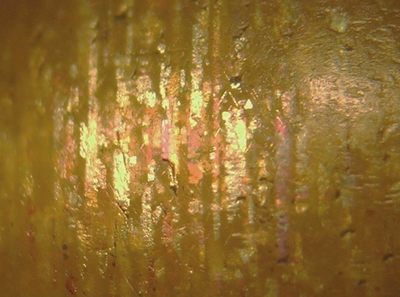
Above: A cabochon cut sunstone, note the band of light across the stone.
To the right is a reflection of the light source, while to the left the haemetite ribbons which produce the
band are just visible.
Below: Detail of the same stone, showing the haemetite ribbons more clearly.
The irridescence is visible. Also note the fine haemetite needles which seems to be at 60 degree
angle to each other as well as the ribbons, this angle suggests a crystal structure.
Damage caused by wear is clearly visible.
Click here
for full-size image.

About Sunstones
A type of feldspar which, like moonstone, shows a band of light across the stone. Sunstones get their effect in a completely different way from moonstones, haemetite ribbons reflect a band of light. The ribbons, as the photo shows, create a band of reflected light across the stone. They are often irridescent when magnified, however that is not visible to the naked eye. Moonstones are normally blue, while sunstones are translucent brown.
While researching the subject I came across a number of references to the Vikings using sunstones to locate the sun on cloudy days; however these stones were almost certainly Iceland Spar, a type of calcite. These stones act as a polarising filter, and the light from the sky is polarised according to the position of the sun.
There is another type of sunstone, Oregan Sunstone, which gets its reflections from minute particles of copper, however it is very rare in Britain, I've never seen an example.
You'll be lucky to find any sunstone jewellery in the UK, the photos here are of the only specimen we own. It was taken from a scrap ring, and is rather scratched. A clear reminder that these gemstones can be easily damaged.
Caring for Sunstones
The stones are soft, and can be scratched by dust etc, so do
not wear them when doing manual work. They should not
come in contact with any jewellery cleaner, but can be washed
with lukewarm water.


